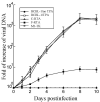Suppressing Kaposi's Sarcoma-Associated Herpesvirus Lytic Gene Expression and Replication by RNase P Ribozyme
- PMID: 37110852
- PMCID: PMC10142857
- DOI: 10.3390/molecules28083619
Suppressing Kaposi's Sarcoma-Associated Herpesvirus Lytic Gene Expression and Replication by RNase P Ribozyme
Abstract
Kaposi's sarcoma, an AIDS-defining illness, is caused by Kaposi's sarcoma-associated herpesvirus (KSHV), an oncogenic virus. In this study, we engineered ribozymes derived from ribonuclease P (RNase P) catalytic RNA with targeting against the mRNA encoding KSHV immediate early replication and transcription activator (RTA), which is vital for KSHV gene expression. The functional ribozyme F-RTA efficiently sliced the RTA mRNA sequence in vitro. In cells, KSHV production was suppressed with ribozyme F-RTA expression by 250-fold, and RTA expression was suppressed by 92-94%. In contrast, expression of control ribozymes hardly affected RTA expression or viral production. Further studies revealed both overall KSHV early and late gene expression and viral growth decreased because of F-RTA-facilitated suppression of RTA expression. Our results indicate the first instance of RNase P ribozymes having potential for use in anti-KSHV therapy.
Keywords: Kaposi sarcoma-associated herpesvirus; RNase P; antiviral; catalytic RNA; gene therapy; herpesvirus; ribozyme.
Conflict of interest statement
The authors declare no conflict of interest.
Figures






Similar articles
-
Engineering of RNase P Ribozymes for Therapy against Human Cytomegalovirus Infection.Viruses. 2024 Jul 25;16(8):1196. doi: 10.3390/v16081196. Viruses. 2024. PMID: 39205170 Free PMC article. Review.
-
Identification of Novel Kaposi's Sarcoma-Associated Herpesvirus Orf50 Transcripts: Discovery of New RTA Isoforms with Variable Transactivation Potential.J Virol. 2016 Dec 16;91(1):e01434-16. doi: 10.1128/JVI.01434-16. Print 2017 Jan 1. J Virol. 2016. PMID: 27795414 Free PMC article.
-
Effective inhibition of Rta expression and lytic replication of Kaposi's sarcoma-associated herpesvirus by human RNase P.Proc Natl Acad Sci U S A. 2004 Jun 15;101(24):9073-8. doi: 10.1073/pnas.0403164101. Epub 2004 Jun 7. Proc Natl Acad Sci U S A. 2004. PMID: 15184661 Free PMC article.
-
Genome-Wide Identification of Direct RTA Targets Reveals Key Host Factors for Kaposi's Sarcoma-Associated Herpesvirus Lytic Reactivation.J Virol. 2019 Feb 19;93(5):e01978-18. doi: 10.1128/JVI.01978-18. Print 2019 Mar 1. J Virol. 2019. PMID: 30541837 Free PMC article.
-
Protein Degradation by Gammaherpesvirus RTAs: More Than Just Viral Transactivators.Viruses. 2023 Mar 11;15(3):730. doi: 10.3390/v15030730. Viruses. 2023. PMID: 36992439 Free PMC article. Review.
Cited by
-
In Vitro Amplification and Selection of Engineered RNase P Ribozyme for Gene Targeting Applications.Methods Mol Biol. 2024;2822:419-429. doi: 10.1007/978-1-0716-3918-4_26. Methods Mol Biol. 2024. PMID: 38907932
-
Engineering of RNase P Ribozymes for Therapy against Human Cytomegalovirus Infection.Viruses. 2024 Jul 25;16(8):1196. doi: 10.3390/v16081196. Viruses. 2024. PMID: 39205170 Free PMC article. Review.
References
-
- Roizman B., Pellett P.E. The family herpesviridae: A brief introduction. In: Knipe D.M., Howley P.M., editors. Fields Virology. Volume 2. Lippincott-William & Wilkins; Philadelphia, PA, USA: 2001. pp. 2381–2398.
-
- Ganem D. Kaposi’s sarcoma-associated herpesvirus. In: Knipe D.M., Howley P.M., Griffin D.E., Martin M.A., Lamb R.A., Roizman B., Straus S.E., editors. Fields Virology. Lippincott-William & Wilkins; Philadelphia, PA, USA: 2007. pp. 2820–2845.
MeSH terms
Substances
Grants and funding
LinkOut - more resources
Full Text Sources

